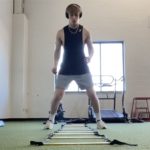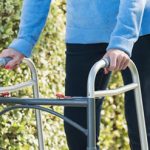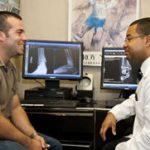The condition: Jeanne Burns, an athletic and active woman in her early 40’s, began having pain in her hips which grew worse over a year’s time. She had to give up running marathons, and as the pain worsened, had to eliminate skiing in the winter, as well as other favorite athletic pursuits throughout the year.
Since Jeanne’s mother had undergone double hip replacement in recent years, she knew her condition was probably hereditary. She made an appointment with Dr. Robert Deveney, a specialist in total hip replacement surgery, who had successfully treated her mother. Dr. Deveney had used the Mako robotic-assisted surgical technique for Jeanne’s mother’s surgery and was able to eliminate her hip pain, so Jeanne was eager to inquire if this procedure would be recommended for her own condition.
The treatment: Upon examination and x-ray, Dr. Deveney determined that Jeanne had developmental dysplasia of the hips, a condition one is born with that impacts the architecture of the hips. Most people aren’t aware they have it until they begin developing pain in their 40’s. In addition to the pain, hip dysplasia is associated with a high risk of developing arthritis as one ages.
Dr. Deveney recommended a similar robotic-assisted procedure for Jeanne to address her hip pain, and scheduled her two hip replacement surgeries six weeks apart.
“Jeanne was a great candidate for the Mako robotic-assisted surgery technique. Robotic surgery allows the surgeon to design and plan joint replacement surgery in a way never done before.” Dr. Deveney explains. A pre-operative CT scan provides a 3-D image of the joint, enabling the surgeon to determine the exact size and position of the replacement optimal for the patient. During surgery, the technology provides immediate feedback so each component can be positioned with greater accuracy, using computer-aided precision.
According to Jeanne, the recovery went far better than expected. She liked being able to go home on the day of each surgery (no overnight stay). In addition, she knew she’d be required to walk the day of surgery, as her mother had done, and was determined to push herself during recovery as much as possible. “Being younger than the typical hip replacement patient helped my recovery greatly,” she commented.
Jeanne’s recovery for each hip involved physical therapy from home immediately after surgery and walking every day. After a week, she was able to go out of her home to on-site physical therapy. “I only used pain medication for a few days,” she adds.
After a few months, she began to return to her more active lifestyle, starting with Pilates and cycling. By winter, approximately eight months after surgery, she could enjoy downhill and uphill skiing (where you walk up the mountain and ski down). Though she hasn’t begun running yet, today, at one year post-surgery, she fully intends to add running back into her repertoire of activities. “I plan to be at 100 percent soon,” she adds.
“The Mako robotic-assisted surgery has changed the landscape for joint replacement,” Dr. Deveney explains, adding, “studies show recovery is more comfortable, and patients get a better result.” As an experienced orthopedic surgeon specializing in total hip and total knee replacement surgery, Dr. Deveney reports that patients reach optimal function sooner using these advanced techniques.



















